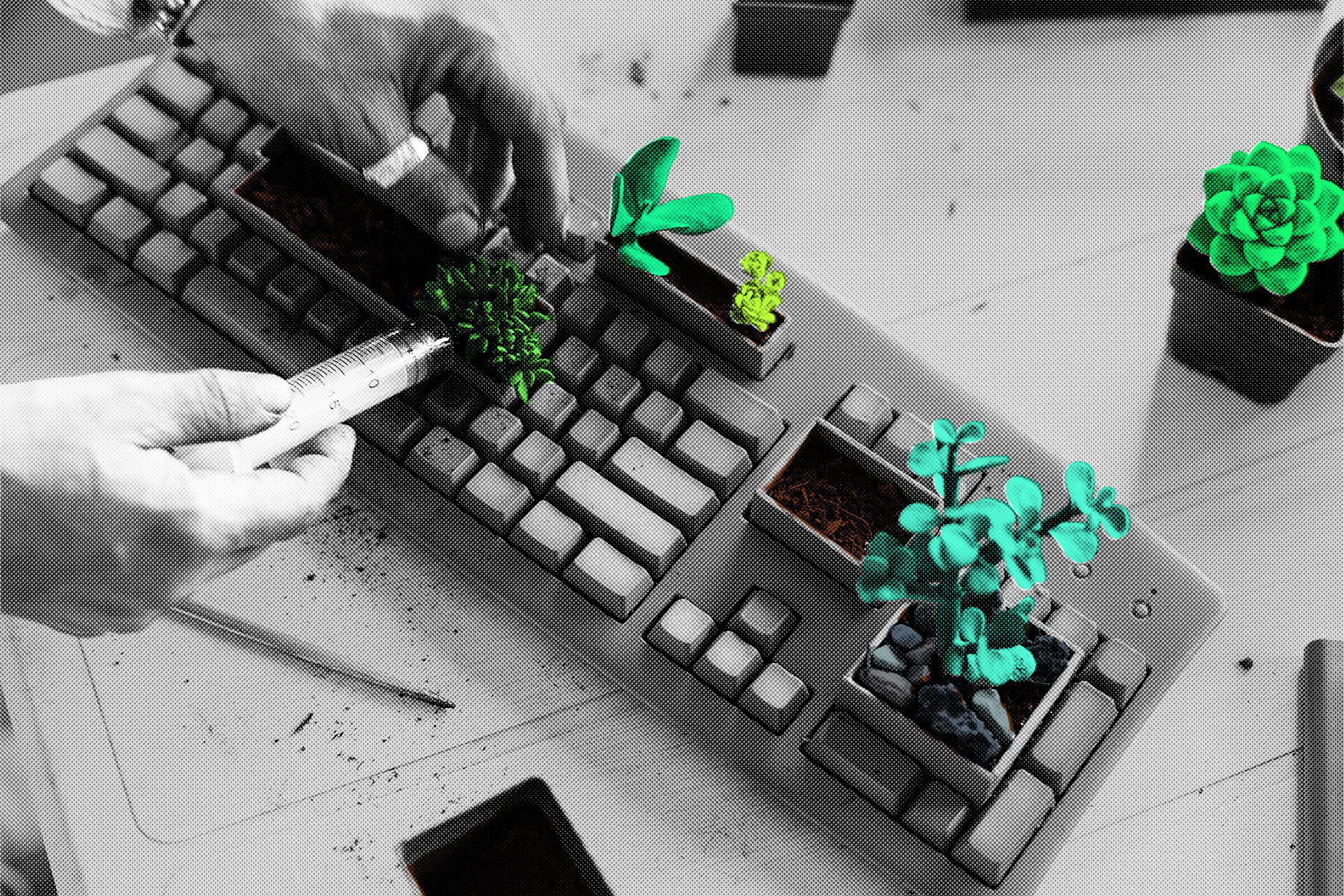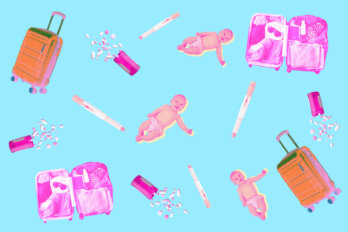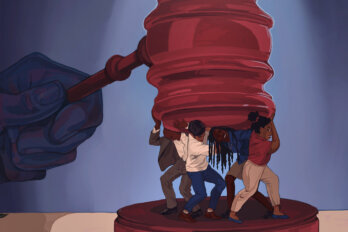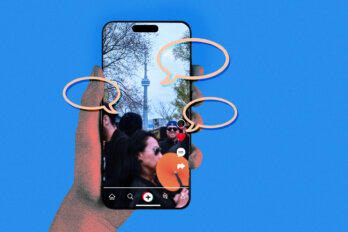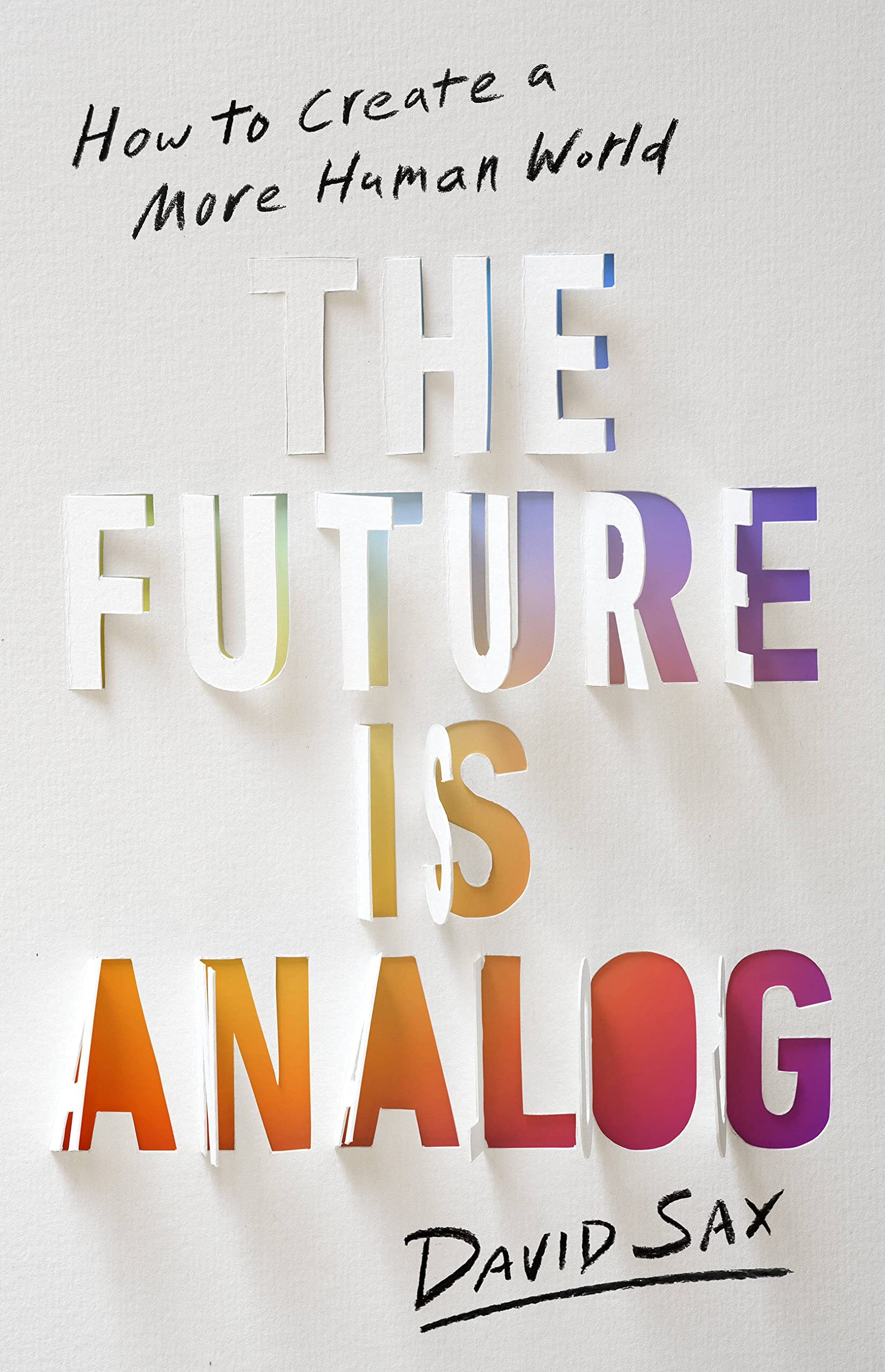 Adapted and excerpted from The Future Is Analog: How to Create a More Human World by David Sax. Copyright © David Sax 2022. Published by PublicAffairs, an imprint of Hachette Book Group. Reproduced by arrangement with the publisher. All rights reserved.
Adapted and excerpted from The Future Is Analog: How to Create a More Human World by David Sax. Copyright © David Sax 2022. Published by PublicAffairs, an imprint of Hachette Book Group. Reproduced by arrangement with the publisher. All rights reserved.The wall we all hit at some point during the pandemic was digital. It was a wall of video meetings, Slack threads, text chains, and emails. A wall built from Netflix and Disney+, Facebook and TikTok, Instagram, and the endless onslaught of urgent tweets. It was the wall in our hands, on our desks, and beside our pillows, a wall that we turned to for salvation but kept smacking into and then wondering why on earth our bodies were so damn beat at the end of each day. The wall was the full unleashed reality of the digital future as it completely consumed our lives.
At first, we tried to deal with it by turning to other digital distractions: documentaries and livestreamed concerts, binge-worthy series, YouTube surfing videos, Roblox and Fortnite and other immersive video games, trivia with friends and online improv, Zoom cocktails and virtual happy hours—but these left us feeling more drained. The exhaustion simply enveloped us. Our eyes were red and dry. Our heads ached. Until, that is, we reached out beyond the wall for the first time in weeks, put down our phones, and seized an analog alternative. We grabbed what was near: a paperback novel on the shelf, an old jigsaw puzzle in the back of a cupboard, a bag of flour whose value was now priceless. We built Lego cities and learned to do woodwork. We fixed bicycles and mucked around in gardens. We tinkered with guitars and amplifiers. We started sourdoughs, first because all the yeast was sold out and then because we became obsessed with its primal, fermenting joy. One Saturday, I painted a Bob Ross–inspired watercolour landscape and then spent three hours making chocolate eclairs. We turned away from digital and sought solace in things we could touch, feel, and sense with our whole bodies.
Sure, people bought fancy internet-connected Peloton bikes and tons of other home-exercise equipment, but more than that, we got outside. We walked until our legs ached and at all hours of the day. Bicycles, cross-country skis, snowshoes, surfboards, tennis rackets, anything to do with camping—if it got you out, it was in high demand. Lakes and rivers filled with paddleboarders. Slackliners and spike ballers congregated on every field. Parks and beaches and campgrounds swelled with the sudden discovery by humanity that we needed to go beyond our screens if we were going to survive this. Hiking trails felt like rush hour on a downtown sidewalk. Our bodies wanted out.
“I would suspect that it’s not just the fact that people got out of the house that they’ll remember,” said Richard Louv, nature educator and author of Last Child in the Woods, about the sudden boom in outdoor recreation during the pandemic. “I think they’ll remember how they felt when they got out.” Louv resides in the remote hills of southern California, where he walks at least five miles a day. He will frequently start off in a bad mood, often driven by something he’s read in the news, and by the time he crests his second hill and spots a mountain-lion track in a dusting of snow, his outlook will have improved. That’s his hope for the legacy of the pandemic—that billions of people around the world experienced something similar, overdosing on what he called the “downsized life” of indoor digital comforts, then rediscovering the beautiful discomfort we felt outdoors. “I think they’ll remember the bonding they did with their families,” Louv said. “They’ll realize that’s a different feeling from when they were watching Netflix. People were watching TV in the beginning, but how many are watching it as much now?” Probably not as many, Louv guessed. The experiences that stuck with people the most were always the ones outside, in nature, away from a screen: hiking in a surprise Mother’s Day snow squall, the first clean wave I caught on that crazy December day surfing, jumping off the dock with my kids into the cold water of Georgian Bay. “No one remembers their best day of watching TV.”
The pandemic was so stressful because it obliterated our sense of time. On the one hand, it seemed as though the world were spinning out of control. We turned on the news or checked our phones, and information just cascaded past us, faster and faster, more violently and with terrifying consequences. Keeping up with it was impossible. There was always another email to answer. Each refresh brought more grim news to digest and respond to. The Slack thread never ended.
But your body was still. You hadn’t gone outside in three days and had been wearing the same ragged outfit for so long, you actually forgot you owned other clothes. Had you showered this week? What week was this? How much of this was due to the unique circumstances of avoiding a contagious virus, and how much was simply the by-product of more time spent online?
“One of the things that the pandemic did was force the whole world to go through a global workshop in slowness, at the same time as forcing us to do more digitally,” said Carl Honoré, author of the bestselling In Praise of Slow and a vocal advocate of a more human-centric pace of life. “It accentuated that experiment with finding the right balance between digital and analog,” he said. “Even before the pandemic hit, the whole Silicon Valley utopianism had run its course, and people were saying there’s aspects coming out of digital that were useful, but we didn’t want to throw the baby out with the bathwater. People were saying, ‘Yes, I want my broadband connection to get faster, but I do still want to have dinner with my family.’”
For decades, Honoré saw the world fall prey to the false promise of a frictionless digital future, a tyranny of never-fulfilled optimizations, where each activity (work, conversations, meals) had to be maximized for output and minimized for time, like an assembly line process Henry Ford demanded speeded up. “Most of the interesting things in the human experience need friction,” Honoré explained, and they benefit from a slower approach: cooking, creativity, thoughtful work, meaningful conversations, relationships. “Digital optimization just leads to a superficial way of being,” he said. “The cult of no friction—it obliterates nuance, texture, depth, solidity, and all those things we need as human beings.” Digital technology has an inherent bias toward speed. The North Star of Silicon Valley is acceleration. For years, we bought into this, even for our health, investing in fitness trackers and connected treadmills, mindfulness apps and sleep-analysis masks, until suddenly we were home alone and our bodies and souls cried out for us to slow the hell down. For once, we actually listened. We stopped and went for a walk. We baked the sourdough and spent days on a 300-piece jigsaw puzzle of a waterfall. We pickled things and built stuff from wood and wrote letters and actually relished the gaping span of time that had always been there but we had been too preoccupied with filling to actually appreciate.
“Moments of crisis focus us to look at what really matters,” Honoré said, noting that the Industrial Revolution led to the slow response of the Arts and Crafts movement, the naturalist ideals of Henry David Thoreau and John Muir, national parks, paid vacation days, and weekends. The false belief was that the future inevitably had to be faster than the past. “If you want all speed, there’s always going to be a pushback with slowness,” he said. “The harder you push speed, digital, and virtual on people, the harder people will push back with slow, analog, hard, physical stuff.” Honoré’s optimism was driven, in part, by the length of the pandemic. The longer we practised slow habits, the better chance we had that they would stick with us in the long run, like the seven-mile walk around London Honoré started doing during the first lockdown and continues with today.
Slowness was not the same thing as doing nothing. That was the highly marketed version of slow: an Instagram photo of “Hot Yoga Girl” sitting in lotus position on a dock, staring out at a mountain lake, with a pithy saying (“Breath Is the Essence of Stillness”) plastered above in coral pink font. All sorts of apps and devices promised to optimize slowness, like the fancy alarm clock with specially researched music to wake you up feeling perfectly right and other consumerist bullshit. The truth is that you can be productive and slow. You can balance digital demands and nourish your body with slow moments. You can value fast broadband and family dinner. Slowness is simply a different approach to the same world we all experience—one that opens up time, shifts our perspectives, and, if we are lucky, leads us to a more balanced dialogue between the body and the soul.
Digital—and all it promises—has become our collective dependence, more powerful and consequential than many drugs. It permeates every aspect of our lives and shapes our very concept of reality. That’s why the pandemic was such a shock to most of us. “We had to start to face our addictions,” said Anita Amstutz, a Mennonite minister in New Mexico, beekeeper, and author of Soul Tending. “The addiction to thinking we’re in control somehow. The addiction to stuff. An addiction to an economic system that basically fell apart. Our addictions to social validation.” When the pandemic began, Amstutz was cut off from her friends and family and forced online for pretty much everything. She realized that the solution was to push herself to spend even more time outside, expanding her soul’s energy into the natural world. “Creation is this interconnected relational world that happens physically, and that we need,” she said. “When we go into nature, we are connected to that relationship. Nature is the revelation of the sacred.”
Look at a picture of a beautiful sunset on Instagram and you think “pretty.” Stand in front of it and watch the sun descend, feeling its rays on your face, and you get a sense of something bigger—your place in this universe. “I mean, how can we let that just go by?” Amstutz asked me, incredulous. “Why are we not awake and aware and falling on our knees in gratitude for this every single day? It’s what keeps us alive, and this world gives us everything we need. That’s the hubris we fall into when we take that for granted.”
The digital-only version of life has profound consequences. We got a taste of those during the early months of the pandemic, and most of us quickly realized the limits of that future. “When you ask people about the most meaningful things, it’s always those analog experiences with nature, people, and spirituality,” said Emily Esfehani Smith, a therapist, writer, and clinical psychologist who wrote Finding Your Meaning. “Without that, you just have these surface digital experiences that don’t penetrate the soul and give people the deeper experiences. People will suffer for it. We need those experiences to feel more healthy and whole. Without them, people will feel more anxious and depressed. Without meaning, people suffer, and there’s a limit to the meaning people can get from a screen.”
Esfehani Smith grew up in an environment imbued with spirituality and mysticism; her parents ran a Sufi Islamic meetinghouse out of their Montreal home. She saw, first hand, the mental health struggles that the pandemic unleashed in her patients, especially teens, and she struggled in her own way with gaining a perspective on them once everything moved online. “I think when we’re constantly in the digital world, we’re in this reality that’s very two dimensional, that’s just not as satisfying,” Esfehani Smith said. “There’s this deeper third dimension that we can’t really access if we don’t step away from the screen. Mystics talk about transcendent experiences being more real than reality itself. In the analog world, you get a sense of that. You get in touch with a reality that’s more real than the one on your screen. It’s the capital R reality.” Jamal Rahman, a Sufi Muslim interfaith minister outside Seattle, summed up that “Reality” by reminding me how the universe is made up of countless atoms vibrating constantly. Our bodies are vibrations. Our words are vibrations. Our movements are vibrations. Nature in all its glory is a great cosmic dance of vibrations. But when we filter our encounters through digital technology, we sever those vibrations. We see the photos and hear the sounds, but our gaze penetrates no deeper than the surface. During the pandemic, we felt that loss acutely, even if we couldn’t understand why.
It is the central truth that any worthwhile soulful experience will always be one where you are physically present. This was what Martin Buber meant when he wrote that “all real living is meeting.” We are a people rooted in real things and places. I come from a tradition whose faithful will travel across the world to utter their deepest prayers to a wall. As humans, we are a tribe, at its strongest when we gather in person: sitting in a prayer hall, singing in a choir, or hugging a friend who just lost their parent, as you hand them a babka. The digital future promises us that we don’t really need that. It promises us easier connections, without sacrifice or boredom, awkward moments and vulnerability, but in the end, it just leaves us hungrier for more, like a diet made up of snacks and meal-replacement shakes when we really want a nice slice of challah and a bowl of chicken soup.
“The term you are looking for is engagement,” said Albert Borgmann, a philosopher in Montana, who has written for decades about the effects of modern digital technology on the soul, describing the missing element I sought out in the analog world. Analog engagement is distinct from the digital kind, which promises more “engaging” experiences, anywhere, anytime. Full-bodied human engagement requires skill. It takes effort. It demands your physical presence and costs something: time, money, energy, your ego. It makes you alert. It is the difference between standing up and half-heartedly singing along with the service in your living room and doing so in a room full of friends, relatives, and strangers. Analog engagement requires vulnerability and even bravery. Like surfing in the winter, it can bring physical risk. But what does it give you in return? “An environment so manifold and rich that no digital version can emulate and simulate and duplicate it!” Borgmann said.
Awareness. Joy. Awe. A sense of belonging. Calm. Soulfulness. These were the things we were suddenly desperate for as we languished in our homes, jumping between screens. We wanted to engage in something. A lump of dough. A puzzle. Fresh air and trees. Water and snow. A shared moment of physical contact with other human beings. We wanted what philosopher Edward S. Reed called a primary experience: a first-hand encounter with the world. Something unmediated and unfiltered, fully absorbed by our bodies, and not shaped, in any way, by algorithms. “It is on firsthand experience—direct contact with things, places, events, and people—that all our knowledge and feeling ultimately rest,” Reed wrote in The Necessity of Experience. The analog experience is the real deal. The source code. The reference point against which every second-hand, digital experience is measured. The further we get away from that and the more we prioritize processed information and predictable digital experiences, the worse our experience of living in the real world becomes. Each time we choose the Zoom service over the real one or the Peloton bike over a ride outside, we are opting for the fast-food equivalent of life: quicker, easier, and more convenient but ultimately unfulfilling, both for our bodies and our souls. “Can we recover our courage as individuals sufficiently to seek real, alive, dangerous, threatening experience?” Reed asked. “To be alive is to enjoy risks and to learn from mistakes . . . Can we come together to relearn the basic truth of human life that lived experience is central to our well-being?”
I hope so.

